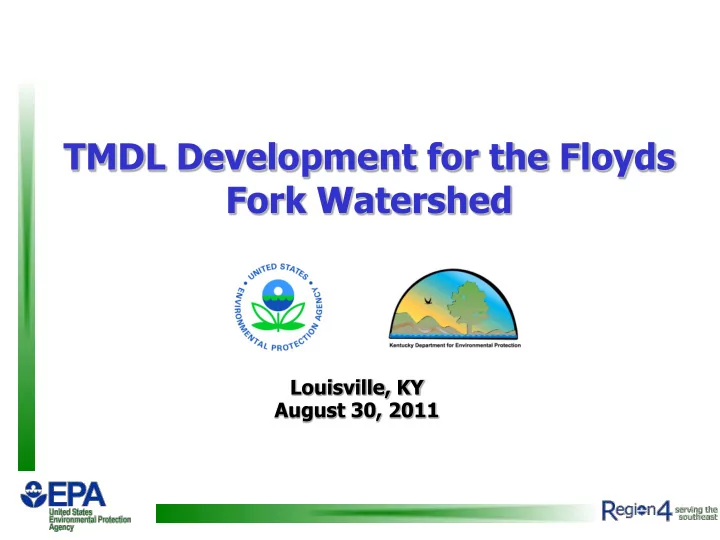

TMDL Development for the Floyds Fork Watershed Louisville, KY August 30, 2011
Presenters • Paulette Akers KY Division of Water • Chris Thomas Chief -- Pollution Control and Implementation Branch • Tim Wool National TMDL Expert Water Quality Modeler, TOM • Brian Watson Director, Water Resources Group Tetra Tech, Atlanta
Opening Remarks • Background – Segments of the Floyds Fork Watershed are on Kentucky’s 303(d) list for: Nutrients (organic enrichment), Dissolved Oxygen & Pathogens – At KY’s Request EPA Started to Develop Nutrient TMDL in 2007 – EPA Receives Notice of Intent in 2011 • Contract awarded to Tetra Tech for the development of watershed and water quality models to be used in a TMDL determination • Period of Performance: May 2011 – November 15, 2012 • Cost: $419,050
TMDL Process
Clean Water Act Section 303(d) Each State shall establish . . . The total maximum daily load. . .at a level necessary to implement the applicable water quality standards with seasonal variations and a margin of safety which takes into any lack of knowledge…………
TMDL Process • Problem Statement – Floyds Fork is listed for: Nutrients and Dissolved Oxygen • Definition of Endpoint – WQS • Dissolved Oxygen: Daily Average 5 mg/L no Less than 4 mg/L • Nutrients: In lakes and reservoirs and their tributaries, and other surface waters where eutrophication problems may exist, nitrogen, phosphorus, carbon, and contributing trace element discharges shall be limited in accordance with: – The scope of the problem; – The geography of the affected area; and – Relative contributions from existing and proposed sources. – Source Identification
TMDL Process – Point Source Dischargers – MS4 Dischargers – Non Point Sources • Linkage Between Sources and Receiving Water • Allocation
TMDLs Overall Allocation Formula: TMDL WLA LA MOS Where: WLA is the Sum of Waste Loads (Point Source + MS4) LA is the Sum of Loads (Nonpoint Source) MOS is the Margin of Safety
Stakeholder Process
Stakeholder Process • Lessons Learned • You are a Valuable Resource – Site Specific Knowledge – Engaged in the Process – Have Individual Concerns • Regulatory Decision Making Process – Proposal – Final
Working Together • EPA will use a stakeholder process in the development of the TMDL – Status of the Model Development will be presented at future meetings – Models will be made available for outside technical review – We encourage your involvement
Approach
TMDL Approach • TMDL will be developed to meet the designated uses and applicable water quality standards • TMDL will address – Current loading conditions – Determine reductions needed to meet TMDL Condition – Allocate to: • Point Sources • Point Source – MS4 • Non Point Sources
Models to be Used • Watershed Model – Loading Simulation Program C++ • Water Quality Model – Water Quality Analysis Simulation Program (WASP) • Both Models have been extensively used for TMDL Development • Both Models have been peer reviewed • Proven track record of linking these models together
Watershed Model -- Background • Visual C++ programming has seamless integration with Microsoft Access and Excel • Same algorithms as HSPF • Simulates watershed hydrology and water quality dynamically • Land use and rainfall based • Outputs flows and concentrations for receiving water model (WASP)
Water Quality Model -- Background • Water quality model • Dynamic • Full Eutrophication Kinetics • Parameters simulated – DO – BOD – Ammonia – Nitrate-Nitrite – Organic Nitrogen – Organic Phosphorus – Ortho Phosphorus – Chlorophyll a
Modeling Approach • Calibrate and Validate to current conditions (2000 – 2010) • TMDL Reduction Scenarios – Determine the load reduction required to meet Water Quality Standards – Provide initial wasteload & load allocations • Implementation – Modeling framework can be used to pollutant sharing and re-allocation
Data Review
Location Map
Elevation (Source: USGS National Elevation Dataset (NED), 1/3 Arc-Second)
Land Use (Source: 2006 National Land Cover Database (NLCD), Pervious)
Land Use (Source: 2006 National Land Cover Database (NLCD), Impervious)
Soils (Source: SSURGO)
Geology (Source: Kentucky Geography Network – kygeonet.ky.gov)
Karst Areas (Source: Kentucky Geography Network – kygeonet.ky.gov)
Point Sources (Source: KDOW and EPAR4)
Sampling Stations (Source: USGS, KDOW, MSD, and WBPs)
Meteorological Stations (Source: National Climatic Data Center (NCDC, USGS)
Septic Systems
Next Steps • Evaluate any new data • Setup the watershed model • Calibrate/validate the watershed model • Next stakeholder meeting – November 2011 • Present watershed model calibration • Present water quality endpoints
Questions?
Recommend
More recommend